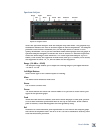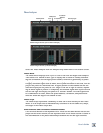
User’s Guide
The Levels Screen
The Levels Screen
Select the Levels Screen from the Analysis drop-down menu. This shows an overview
grouping of the primary meters of the Analysis section. Each meter can be isolated
and expanded for a detailed view of the selected audio measurement, by selecting a
meter and double-clicking on the display. The expanded meters can be minimized by
clicking again. The individual meters are explained in more detail below:
Peak Level
Peak Level (expanded view)
Peak Level presents a fast-responding peak level with slow decay. Additionally, an
Overload LED can detect digital clip. As digital distortion is very unforgiving, this
meter is useful in maintaining an optimum peak level from your input signal or as
a highly visible guide inserted on the master outputs. Obviously it’s crucial to avoid
digital clipping, but it’s also important to maintain enough level to sample in the best
sounding range of the D8B’s gain structure. The range is –96 dB to 0 dB.
Peak Level Meters, sometimes called PPM (Peak Program Meters) respond to within
1 dB of the actual peak level within 10 ms, and within 4 dB in 3 ms, to capture very
fast transients that are ignored by the slow response of an averaging VU or RMS me-
ter. Peak Level does not demonstrate the loudness of your program. The difference
between Peak and VU meters can be as much as 12 dB or 4x the apparent volume.
Many engineers therefore combine the best of both worlds by using both Peak and
VU metering for the best results. The Overload Clip light responds to a single sample
of digital clip and remains on for two seconds after the last measured clip.
Peak
RMS
VU
Loudness
Sum/Diff
Correlation
Loudness Balance


















